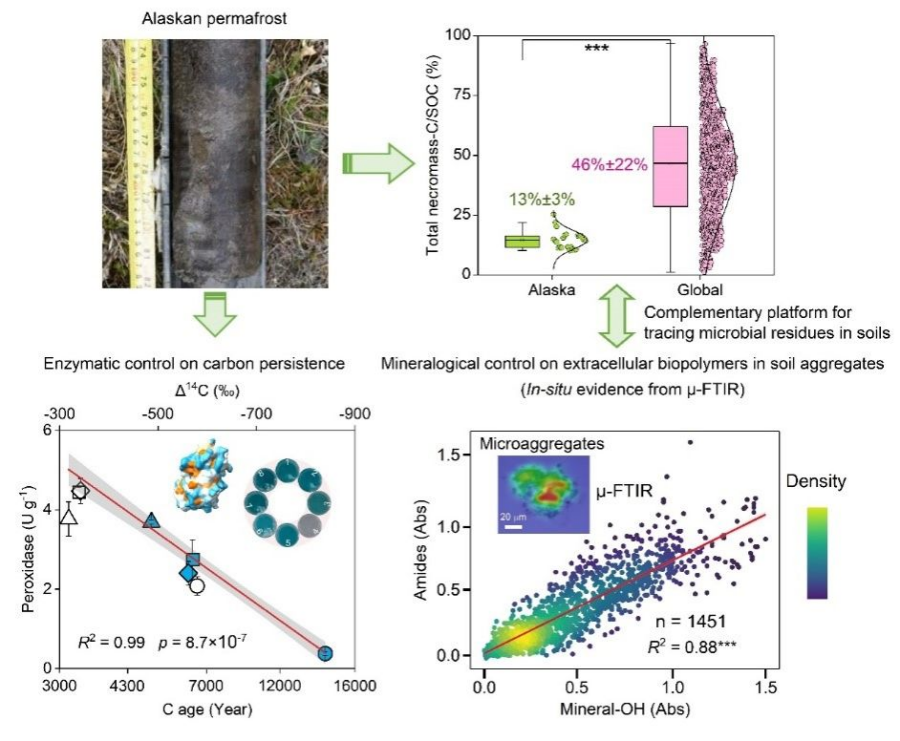A groundbreaking international study led by researchers from Tianjin University has revealed crucial insights into how carbon persists in Arctic permafrost soils, challenging existing theories and providing vital understanding of climate change dynamics.

Permafrost regions in high-latitude areas represent a critical tipping point in global climate change, storing approximately 50% of global soil carbon—surpassing the combined carbon content in the atmosphere and vegetation. With Arctic regions warming 2-4 times faster than the global average, understanding carbon stability in thawing permafrost has become increasingly urgent.

Distribution of Arctic Permafrost Sampling Sites
The research team, led by Professor Yu Guanghui from the Center for Interface Processes and Soil Sphere Evolution at Tianjin University, made several significant discoveries through their comprehensive analysis of Alaskan permafrost.
The study revealed that soil organic carbon in Alaskan permafrost is thousands of years old, yet surprisingly resilient. Contrary to prevailing theories, the research shows that microbial necromass carbon accounts for only 10-15% of organic carbon in the permafrost—significantly lower than the global average of 30-60%. This finding challenges existing paradigms about carbon storage mechanisms in these crucial ecosystems.
A key discovery was the relationship between carbon persistence and enzyme activity. The researchers found that peroxidase activity showed a remarkably strong correlation with carbon age and composition, suggesting its crucial role in determining carbon stability. Importantly, increased peroxidase activity appeared to enhance the protection of plant residues by promoting mineral-organic associations.

Organic Carbon Stabilization Mechanisms in Deep Arctic Permafrost
Using advanced synchrotron radiation infrared spectromicroscopy, the team analyzed over 1,450 soil aggregate spectra, providing unprecedented detail about how mineral surfaces interact with organic matter at the submicron scale. This analysis revealed strong correlations between mineral hydroxyl groups and organic functional groups, offering new insights into carbon stabilization mechanisms.
The study also highlighted potential vulnerabilities in this carbon storage system. Laboratory experiments demonstrated that increased soil moisture, particularly in the 0-40% range, significantly enhanced peroxidase activity. This finding suggests that as permafrost thaws, ancient carbon stores could become increasingly unstable due to moisture changes.
“This research provides critical mechanistic insights into how carbon persists in thawing permafrost soils," said Professor Yu. "Understanding these processes is essential for predicting and potentially mitigating permafrost carbon-climate feedbacks.”
The study, titled "Deciphering the Intricate Control of Minerals on Deep Soil Carbon Stability and Persistence in Alaskan Permafrost," represents a collaborative effort among researchers from multiple institutions, including North Carolina State University, Chinese Academy of Sciences, University of Tübingen, University of Wisconsin, and Leibniz University.
These findings are particularly significant as scientists predict that Arctic permafrost thawing could dramatically increase if global temperatures rise above 2°C, potentially triggering a cascade of effects in global ecosystems and climate systems. The research provides crucial data for improving climate models and understanding the potential impact of permafrost thaw on global climate change.
By Eva Yin






